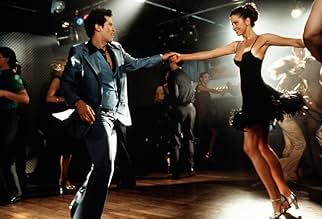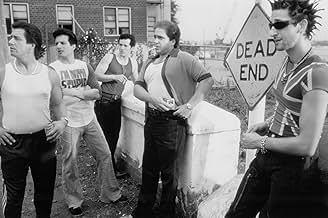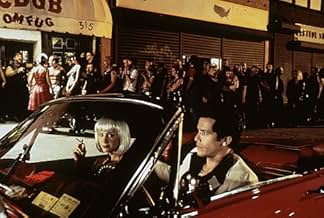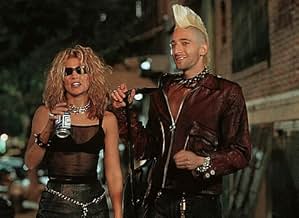Le indagini su vari omicidi a New York City durante l'estate del 1977 è incentrata sugli abitanti di un quartiere Italo Americano del nordest del Bronx in cui vivono nella paura e nella sfid... Leggi tuttoLe indagini su vari omicidi a New York City durante l'estate del 1977 è incentrata sugli abitanti di un quartiere Italo Americano del nordest del Bronx in cui vivono nella paura e nella sfiducia l'uno dell'altro.Le indagini su vari omicidi a New York City durante l'estate del 1977 è incentrata sugli abitanti di un quartiere Italo Americano del nordest del Bronx in cui vivono nella paura e nella sfiducia l'uno dell'altro.
- Regia
- Sceneggiatura
- Star
- Premi
- 7 candidature totali
- Mario
- (as Arthur Nascarella)
Recensioni in evidenza
Lee's tale has the actually serial killer in the background, an interesting idea that allowed him to focus on the evils of the citizens in the neighborhood: little bits of racism and homophobia, a good dose of misogyny and the double standard in the attitude and philandering of a married guy (Leguizamo), and most effectively, the turning loose of the mob to both loot during the blackouts, and to target individuals unfairly deemed suspects in the killings, like the guy from the neighborhood who wants to be a punk rocker (Brody).
Unfortunately, Lee got a little overindulgent in focusing on these people, and aside from creating characters that sometimes seemed like shallow clichés, the script veered too often into sexual antics. The married couple going from his numerous affairs to her trying to please him through dressing up, asking for sexual advice, going to an orgy, etc felt like a little much. The friend who aside from wanting to be a punk rocker also dances provocatively and services men in a gay nightclub did too. You could say this is a hot mess of a film, and at 142 minutes, it went on too long.
With that said, I was always engaged, and found Lee's memory of this period (he was 20 in 1977) to have a certain intimacy, one with a refreshing darkness that contrasts the buoyant songs of the day, any semblance of sentimentality reserved only for his beloved New York Yankees. Speaking of which, I loved the lines speculating that the killer might be Reggie Jackson - the Son of Sam, Uncle Sam, New York Yankee wearing #44, the caliber of the handgun used.
Unfortunately, many of the subsidiary characters, who surround these two and keep pulling us away from them, emerge as little more than ethnic and sexual stereotypes, from the neighborhood mob boss (Ben Gazarra) to the loving-father drug dealer to the punk rock iconoclast to the local flaming "fairy." Not even strong performances by a game cast can infuse these roles with the depth and humanity necessary to justify their inclusion in the film.
Stylistically, this film is much less visually flashy than previous Lee works with less elaborate camerawork and only the occasional near-subliminal quick cuts (used to convey memories) to distract us. Lee should, also, have avoided at all costs the temptation to cast himself as an on-site news reporter. Even more egregiously, why oh why did Lee feel compelled to visualize literally (through animatronics) the demon dog that Berkowitz reportedly cited as the motivation for his crimes actually barking out instructions to the crazed psychopath?
The risk in these docudramas is that the moviemakers will not be able to match, in their narrative, the compelling nature of the actual events upon which they are based. Lee's film is no exception, for just as the killer is captured, the fictional side of the story resolves itself in a flurry of heavy handed "Ox Bow Incident" melodramatics, scarcely credible even for a cadre of characters as lacking in common sense as these are. "Summer of Sam" is notable for the performances of John Leguizamo and Mira Sorvino in the central roles, its disco-drenched soundtrack and its letter-perfect recreation of a particular moment in recent American history. What a shame, then, that the film never really coheres into a satisfying whole.
Summer of Sam brutally zooms in on an Italian-American South Bronx neighbourhood in the summer of 1977 -- the hottest summer ever, a real killer. Lee does not shy away from sex, drugs, raunchy dialogue or violence in his portrayal of the events which are based on reality of the summer nights when Sam murdered women on the streets. As the Bronx inhabitants grow anxious and suspicious of the murders, Summer of Sam focuses its story on Vinny (John Lequizamo), his marriage with Dionna (Mira Sorvino) and his friends and we see how the killings affect their lives, while plating the "Son of Sam" himself in the backseat to make room for these dynamic characters.
I can admit that there is no strong point or focus in this film, but I don't think it's entirely necessary. It's a portrayal, and a realistic one at that -- it is also a portrayal of an era, the 1970s and this is most apparent in the flashy 54-styled nightclubs that Vinny and Dionna go to. It occasionally drags on, but this is good because it emphasizes the terrible heat and anxiousness of the city, making it almost nightmarish. It is so realistic that you can almost feel the heat and dirt on your clothes as if you were right there in steaming hot New York City. I therefore feel that a great deal of praise is due to a film that succeeds in being haunting without actually dealing with the murders head-on.
8/10
Lo sapevi?
- QuizSpike Lee was facing a lot of negative feedback from the family members of the victims who didn't want a film being made which might glorify the killer in some manner. As a result, the script had to be changed which focused more on the community than the killer himself. "Son of Sam" was rumored to be the original working title.
- BlooperAt the beginning of the movie, set in the summer of 1977, characters are seen dancing in a disco to the song "There But For the Grace of God Go I" by Machine. The song wasn't recorded until 1979.
- Citazioni
Vinny: Come on, get in the car. Please, baby.
Dionna: Baby? Don't you dare "baby" me! I'm gonna wait here! I'm gonna wait here until somebody comes along. You know what? I'm gonna wait here until some soul brother comes along in his big black Cadillac. And you know and I know that he's got a big black dick too.
Vinny: Don't talk like that, just get inside the car.
Dionna: Oh, fuck you!
Vinny: Please, please, don't make me have to beg you. Get in the car. Come on- don't make me have to hurt you.
Dionna: Hurt me? Don't you even fuckin' lay a pinkie on me! I'll get him to kick your ass and then I'll fuck 'em! You wanna watch Vinny? Will that turn you on Vinny? You linguine dick mother fucker. You wanna watch while I suck a big black dick in the back of a big black cadillac?
- Curiosità sui creditiThe credits are in the form of newspaper headlines.
- Versioni alternativeAfter they are refused entry into Studio 54, the sex scene between Dionna (Mira Sorvino) and Vinny (John Leguizamo) included more explicit shots in the original cut. This scene was edited a bit after the MPAA threatened the film with an "NC-17" rating.
- ConnessioniEdited into Doggiewoggiez! Poochiewoochiez! (2012)
- Colonne sonoreFernando
Written by Benny Andersson, Stig Anderson and Björn Ulvaeus (as Bjorn Ulvaeus)
Performed by ABBA
Courtesy of Polar Music International AB
Under license from Universal Music Special Markets
I più visti
Dettagli
- Data di uscita
- Paese di origine
- Lingue
- Celebre anche come
- La noche del asesino
- Luoghi delle riprese
- Bronx, New York, New York, Stati Uniti(On Morris Park Ave. between Williamsbridge Rd. and Bronxdale Ave.)
- Aziende produttrici
- Vedi altri crediti dell’azienda su IMDbPro
Botteghino
- Budget
- 22.000.000 USD (previsto)
- Lordo Stati Uniti e Canada
- 19.288.130 USD
- Fine settimana di apertura Stati Uniti e Canada
- 5.952.452 USD
- 4 lug 1999
- Lordo in tutto il mondo
- 19.288.130 USD
- Tempo di esecuzione2 ore 22 minuti
- Colore
- Mix di suoni
- Proporzioni
- 1.85 : 1
Contribuisci a questa pagina






































